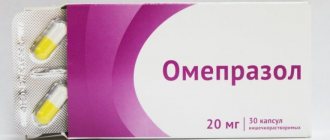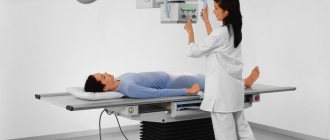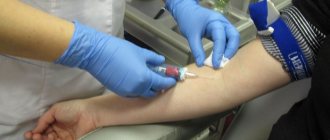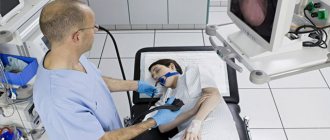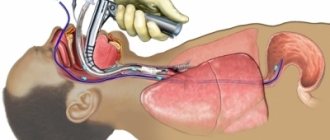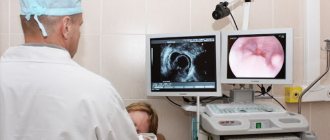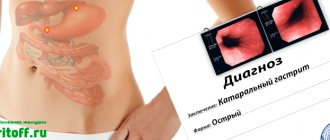Gastric pH-metry is a study of the secretory function of different parts of the stomach. The examination is necessary to diagnose diseases associated with the acid-forming ability of the stomach, as well as related diseases of the oral cavity, ENT organs, bronchi and heart. The study is especially important in cases where generally accepted treatment regimens do not give the expected results.
What does the procedure reveal?
pH-metry is the best way to diagnose such conditions:
- GERD – backflow of stomach contents into the esophagus;
- stomach or duodenal ulcer;
- chronic gastritis - definition of different forms;
- duodenitis – chronic inflammation of the duodenum;
- lazy stomach syndrome or dyspepsia;
- pancreatic adenoma or Zollinger-Ellison syndrome;
- changes in the lining of the esophagus due to chronic acid damage or Barrett's esophagus;
- control of treatment with medications that reduce the secretion of hydrochloric acid;
- testing the individual effect of drugs to reduce acidity;
- control of function after removal of part of the stomach.
The study is carried out using an acidogastrometer, the working part is a probe with a pH sensor.
pH-metry of the stomach, how it is carried out. Methods of intragastric pH-metry
Titration methods using coloring indicators do not allow one to accurately determine the acidity of gastric contents with an admixture of bile and blood; in addition, acidity in the pH range from 3.5 to 7.0 is defined by these methods as anacidity. More accurate data on the true acidity of gastric juice is provided by measuring the concentration of free hydrogen ions using intragastric pH-metry.
Currently, in the absence of contraindications to the insertion of a probe (severe general condition, old age, varicose veins of the esophagus, diverticula of the esophagus, aortic aneurysm, high blood pressure, severe organic lesions of the cardiovascular system), preference is given to the study of gastric acid formation using electrometric pH-metry using the method of 24-hour pH monitoring (the most informative type of method, recently used in clinical settings).
The method is based on determining pH using special electrodes based on the electromotive force in solutions. The development of highly sensitive pH probes and the possibility of placing sensors in various parts of the esophagus, stomach and duodenum allows, under physiological conditions, to study the state of the acid-forming function of the stomach (ACF), the alkalizing function of the antrum of the stomach, the degree of acidification of the duodenum or esophagus (with gastroesophageal reflux) , study the CFG while taking drugs that block gastric secretion. Daily monitoring allows you to assess changes in CFG during eating, smoking, and night sleep.
Intragastric pH-metry is carried out using special probes equipped with several (two or more) pH electrodes (glass or antimony-calomel). Currently, the most common are domestic antimony-calomel probes of the E. Yu. Linara system and devices (acidogastrographs) for short-term (Gastroscan-5) and long-term (Gastroscan-24) intragastric pH-metry (Fig. 5.61). For intragastric pH-metry acid production is measured at short intervals directly in the acid-forming zone, in the esophagus, antrum and duodenum.
Monitoring is of great importance for studying the daily profile of HCl secretion in patients with gastric and duodenal ulcers, its severity at certain time intervals: on an empty stomach, at night, after meals, taking medications.
With the help of 24-hour monitoring of the pH of the stomach, esophagus and duodenum, it became possible to determine the pathogenetic significance of not only the level of acid formation in the stomach itself, but also to evaluate its pathological effect on the esophageal mucosa in GERD. 24-hour intraesophageal pH monitoring of the esophagus allows you to adequately assess the type of reflux (acid or bile), identify the total number of reflux episodes during the day and their duration, the relationship of reflux with body position, time of day, and its dependence on food intake. During the study, the patients being examined are advised not to change their usual lifestyle and diet. The presence of GERD is indicated if the total number of episodes of GER during the day is more than 50 or the total duration of the decrease in pH to a level of less than 4 exceeds 1 hour. 24-hour pH-metry is the leading method, a kind of “gold standard” for verifying the diagnosis of GERD, in diagnosing atypical forms of GERD, detecting the phenomenon of “night acid breakthrough” (NAB), as well as in individual selection of medications.
Types of examination
Depending on the goals and methodology of implementation, there are 3 main types of research:
- short-term – within 2-3 hours;
- daily – for 24 hours or more;
- endoscopic - during FGDS.
Each method has its pros and cons.
| Methodology | Advantages | Flaws |
| Short term |
|
|
| Daily allowance |
|
|
| Endoscopic |
|
|
Be sure to read: Antisecretory agents: list and types of drugs, application features
There is another type - express pH-metry, when the amount of hydrochloric acid is determined only in the body of the stomach. The duration of this procedure is about 30 minutes.
For practical purposes, the short-term technique is most often used. The Neller test performed during it is the introduction of a solution of baking soda and recording fluctuations in the level of hydrochloric acid after this. First, hydrochloric acid is neutralized, and after a certain period (“alkaline time”) the indicator returns to its previous level. Using these parameters, you can accurately assess the acid-forming function of the stomach.
The normal concentration of gastric hydrochloric acid is 160 mmol/l.
pH is a standard unit that reflects the activity of hydrogen ions.
Intracavitary pH-metry as a modern method for studying gastric secretion
Doctor of Medical Sciences, Associate Professor V.V. Skvortsov, Ph.D. A.V. Tumarenko, E.M. Skvortsova, V.V. Odintsov
Almost all diseases of the upper gastrointestinal tract (GIT) are, to one degree or another, correlated with the effect of acid produced during the digestion process on the mucous membrane of the GI tract. For correct diagnosis (and sometimes treatment) of many of these diseases, it is necessary to study the acid-producing and acid-neutralizing functions of the gastrointestinal tract. The possibility of determining intragastric acidity using a special pH-metric probe was first described by McCledon in 1915.
Until the early 80s of the twentieth century, the goal of developing equipment for intragastric pH-metry was to substantiate the need for the method and create pioneering medical techniques. The first serial devices and pH probes in the USSR were designed in the city of Fryazino, Moscow Region, under the leadership of Academician of the Russian Academy of Sciences N.D. Devyatkova. In the last decade, the leading role in the development and production of domestic devices for intracavitary pH-metry belongs to the Fryazino research and production enterprise Istok-System.
Clinical problems solved using intragastric pH-metry. The advent of pH-metric instruments initiated the development of clinical studies of acid-dependent processes in the human body. pH-metry is of particular importance in the diagnosis of GERD. According to the “Recommendations for the examination and treatment of patients with gastroesophageal reflux disease” (Ivashkin V.T. et al., 2001), “The main method for diagnosing GERD is pH-metry.” However, the diagnosis of GERD, although the most recognized, is far from the only area of application of pH-metry. In modern medicine, pH measurement is used to solve the following problems.
Diagnostic tasks
Among them, the most relevant are: - topographic intragastric express pH-metry of the gastrointestinal tract - short-term (up to 3 hours) study of basal and stimulated secretion of gastrointestinal tract; — long-term (up to 24 hours or more) monitoring of gastroesophageal reflux (GER); — study of fast acid processes, such as duodenogastric reflux (DGR); — parietal intraendoscopic pH-metry; - long-term monitoring of acidity in the esophagus in order to study the role of GER in bronchopulmonary and ENT diseases: chronic cough, pneumonia, bronchial asthma, sinusitis, dysphonia, laryngitis, broncho-obstruction, contact granuloma, pharyngitis, dental erosion, malignant lesions of the pharynx, larynx, vocal cords, as well as research into the role of GER in the occurrence and development of sleep diseases; — simultaneous long-term monitoring of acidity in the gastrointestinal tract and electrical activity of the heart for the purpose of differential diagnosis of cardio- and gastrointestinal diseases and for the study of heart diseases caused by GER; simultaneous monitoring of acidity in the gastrointestinal tract and electrical activity of various parts of the gastrointestinal tract. Tasks associated with assessing the effects of pharmacological drugs: - selection of drugs and their dosages for optimal drug treatment of specific patients; — assessment of the effectiveness of drugs (or complexes of drugs) on patients suffering from certain diseases; — research related to obtaining permits for the use of certain pharmacological drugs in medical practice.
Devices for intracavitary pH-metry are in demand in solving numerous research problems, among which, in addition to the creation and testing of new methods for diagnosing and treating diseases of the gastrointestinal tract, including combined ones, we note the study of acid-dependent processes in the lower parts of the gastrointestinal tract, in the oral cavity, intravaginal and transurethral pH-metry.
Devices for intracavitary pH-metry
1. Microprocessor acidogastrometer “AGM-03” is the basic device of a series of inexpensive acidogastrometers. Designed for studying basal and stimulated acidity of the gastrointestinal tract, conducting alkaline, acid and other tests, as well as for selecting medications. A separate area of its application is topographic intraendoscopic pH-metry.
2. Computer stationary acidogastrometer “Gastroscan-5M”. Designed for short-term (including stimulated) pH-metry of the gastrointestinal tract in up to five patients simultaneously, in one, two, three or five sections of the gastrointestinal tract. The pH measurement period is 20 or 5 s. Gives tips to medical personnel on conducting the examination. Issues a conclusion about the state of the gastrointestinal tract. Saves research results in a database and performs various types of statistical processing of the research array. Allows for individual selection of drug therapy.
3. Daily wearable acidogastromonitor “Gastroscan-24”. The Gastroscan-24 computer device is intended for long-term (up to 24 hours or more) study of the acidity of the gastrointestinal tract. For processing, the measurement results after the end of the examination are transferred to a personal computer (PC). The device allows you to evaluate the effect of medications, select them and take them. During the study, using the keyboard equipped with the wearable unit, the patient enters data about his condition (pain, heartburn, nausea, etc.) or actions (smoking, taking medications, etc.).
4. Gastrocardiomonitor “Gastroscan-ECG”. The device is designed for simultaneous 24-hour monitoring of acidity at three points in the gastrointestinal tract and cardiac signal in three leads. Such monitoring allows for differential diagnosis of chest pain of unknown etiology based on correlation analysis of changes in acidity and cardiac signal.
5. pH-metric probes. NPP "Istok-System" serially produces a variety of pH probes that differ in design and application: a) oral, transnasal, endoscopic; b) having 1, 2, 3 or 5 measuring electrodes; c) in age versions approved by the Ministry of Health of the Russian Federation - 4 children and 1 adult (multielectrode pH probes). All pH probes provide a measurement accuracy of 0.2 pH over a range of 1.1 to 9.2 pH. Currently, gastroenterology is one of the fastest growing areas of therapy. To a large extent, this progress is due to the introduction into clinical practice of modern, high-tech methods for studying the functions of the digestive organs.
On the other hand, knowledge of the physiology of the processes of secretion, digestion, and motility in the gastrointestinal tract is expanding every year, which forces, in some cases, to rethink the methods, purpose and interpretation of the results of traditional, routinely used research methods in gastroenterology. Until relatively recently, functional diagnostics in gastroenterology was a tool in the hands of a few researchers, with the help of which they could assess the degree of dysfunction of a particular organ of the digestive tract.
Currently, a large amount of factual material has been accumulated, which allows not only to diagnose the severity of functional disorders, but also, importantly, to verify the patient’s diagnosis.
Gastrointestinal intubation for pH measurement
Contraindications. In each specific case, it is necessary to correlate the severity of the patient’s condition and the expected diagnostic value of the study. The use of microprobes reduces the number of contraindications to probing. However, the question of the appropriateness of this study must be decided individually in the following cases: diseases of the oral cavity, nose, pharynx that prevent the insertion of a probe or the patient’s breathing; diverticula, esophageal strictures; severe uncontrolled coagulopathy; bronchial asthma, cardiovascular diseases, in which stimulation of the vagus nerve is contraindicated; severe respiratory failure; recent gastric surgery; tumors and ulcers of the esophagus; varicose veins of the esophagus; mental illnesses (neuroses, psychopathy, hysteria) in the absence of mutual understanding with the patient.
Complications of intubation: bleeding from the nose or throat; injury to the nose or throat; tracheal intubation; trauma or perforation of the esophagus, stomach; vomit; syncope associated with irritation of the sensitive afferent fibers of the vagus nerve system, due to the initiation of the vasovagal reflex (an efferent discharge occurs, conducted along the motor fibers of the vagus nerve and causing cardiac arrest); bronchospasm; exacerbation of trigeminal neuralgia; patient infection.
Probing equipment for pH measurements: probe; aerosol, gel for anesthesia; vomit tray; towel; rubber gloves, portable pH meter.
Preparation for pH-metry Intubation is carried out no less than 6 hours after eating. 3-4 hours before the start of the study, smoking, drinking liquids, and chewing gum are excluded. If the evacuation of contents from the stomach is impaired on the evening before the study, the stomach is lavaged through a thick probe until clean lavage water is obtained. Before the study, it is necessary to clarify what medications the patient took on the eve of the study. Most methods require discontinuation of previous medications. The time for limiting the intake of medications depends on the duration of their effect and the method used, for example, with pH-metry, antacids and anticholinergics must be discontinued 12 hours before, H2-histamine blockers 24 hours before, and proton pump inhibitors 36 hours before.
It is important to carefully study the patient’s medical history and listen to his complaints at the time of the study. This is necessary to exclude the patient from possible contraindications for the study, allergies to medications used for anesthesia. In order to reduce neuropsychic stress and prevent complications during the study, it is necessary to explain the procedure to the patient and note its safety.
Intubation technique
Immediately before the test, place the probe in warm water for a while to minimize temperature changes in the catheter and increase its elasticity. Place the patient in a chair. If the probe is inserted through the nose, ask the patient to breathe deeply with the mouth closed, alternately pinching one of the nostrils, to assess nasal breathing. Intubation is carried out through the nasal passage with the most effective nasal breathing. Test the gag reflex by touching the uvula or pharynx. Patients with a weak or absent gag reflex are at greatest risk for pulmonary aspiration. If there is no allergy to the drug, anesthesia of the nasal passage or pharynx is performed with an aerosol anesthetic (lidocaine, etc.). However, some patients tolerate repeated examinations well even without local anesthesia. After the onset of anesthesia, the probe is slowly and carefully inserted into the nasal passage, or into the mouth, and then into the patient’s throat. When inserting a probe into the nasopharynx, the patient is recommended to tilt his head forward so that the chin touches the chest. Tilt of the head forward leads to the closure of the trachea by the epiglottis and facilitates the passage of the probe into the esophagus. At the moment of insertion of the probe, the patient breathes deeply and makes swallowing movements. The appearance of a cough indicates that the probe is not installed correctly. If there is hypertonicity of the lower esophageal sphincter (achalasia cardia), the probe may twist in the distal part of the esophagus. In this case, it is necessary to remove the probe and slowly insert it again. The probe advances to the desired depth. During the study, it is necessary to monitor the patient's reaction, since gastric intubation and fear can lead to acute vasomotor reactions, including loss of consciousness. The probe is secured with a patch on the cheek and behind the ear.
Before starting the study, it is necessary to allow the patient to get used to the probe. In most studies, saliva is spat into a special tray. To conduct the study, equipment is used for long-term monitoring of acidity, consisting of a compact wearable pH recording unit, to which is attached a pH-metric probe, inserted transnasally into the patient’s stomach, and a computer with software. The panel of the wearable unit has special buttons, by pressing which the patient registers in the device’s memory the time of occurrence and duration of pain, dyspeptic symptoms, food intake and other events. Intracavitary pH is determined at set time intervals from 1 to 60 s in various devices.
pH is measured on an empty stomach in the body and antrum (6-7), normally in the antrum after administration of histamine pH = 4-7. The conditional norm for stimulating secretion with extractive substances is considered to be pH = 1.7-1.5 in the body of the stomach, and with maximum stimulation with histamine - 1.2-1.1. If the pH remains above 1.8 during histamine stimulation, then the likelihood of atrophy of the gastric mucosa is significant.
To assess intragastric acidity, the following types of intragastric pH measurements are used: Topographic express pH measurements. Intragastric pH monitoring. Topographic transendoscopic pH-metry. Topographic intragastric express pH-metry A probe is inserted into the patient's esophagus on an empty stomach up to the lower esophageal sphincter. The length of insertion of the probe is approximately determined by the distance from the patient’s earlobe to the xiphoid process or from the upper lip to the navel. Then, as the probe is further introduced, pH measurements are taken every centimeter. A total of 20 pH measurements are taken for no more than 3 minutes. The probe is fixed and left in the stomach for 10 minutes. After 10 minutes, the probe is removed, and the pH is also measured every centimeter. For the study, acidogastrometers AGM-01, AGM-03 and Gastroscan-5M are used. The pH values upon insertion of the probe determine the level of fasting acid formation. pH values when removing the probe allow you to assess the level of basal acid formation. When performing pH measurements, it is important to consider in which part of the stomach the sensor is located.
In the antrum of the stomach, in most cases the pH is higher due to the neutralization of hydrochloric acid by the alkaline secretion of the glands. At the same time, the degree of severity of the acid-neutralizing function of the stomach is determined by the difference in pH between the antrum and body of the stomach. If the pH difference is 2.1 or more, compensated alkalization is diagnosed, 1.0-2.0 - subcompensated, 1.0 or less - decompensated alkalization in the antrum. There are research schemes when the pH is recorded for 45 minutes under basal conditions, and then over the next 45 minutes after stimulation of secretion. To stimulate gastric acid formation, the same medications are used as for multi-stage gastric intubation (histamine dihydrochloride, histamine phosphate, gastrin (2 mcg/kg), pentagastrin (pentavlon) at a dose of 6 mcg/kg, etc.
The main disadvantage of the method is the inability to estimate the volume of gastric contents and, as a result, acid production. However, the Neller alkaline test helps to indirectly assess acid production. The alkaline test involves introducing a solution of 0.5 g of baking soda (NaHCO3) into 30 ml of boiled water through the pH probe channel. It is carried out 20 minutes after stabilization of the pH under basal conditions or 45 minutes after the introduction of stimulants. This technique allows you to get an idea not only of the concentration of hydrogen ions in the lumen of the stomach, but also of the amount of gastric juice, i.e. hydrochloric acid products. The indicator of this test is the alkaline time - the interval between the increase in pH after the introduction of the solution until it returns to the original level. Normally, in the body of the stomach it ranges from 15 to 30 minutes. A decrease in alkaline time of less than 15 minutes indicates an increase in the flow rate of hydrochloric acid, an increase of more than 30 minutes indicates a suppression of acid formation.
The test is carried out under basal and stimulated conditions. If acid formation is high, an atropine test is performed. It makes it possible to differentiate the neuroreflex mechanism of basal acid production from the humoral one. The test is carried out both under basal conditions and when secretion is stimulated. In this case, 1 ml of a 0.1% solution of atropine sulfate is injected subcutaneously and the pH in the body of the stomach is recorded for an hour. The results of the atropine test under basal conditions are assessed by the degree of pH increase in the body of the stomach. When the pH increases by more than 2 units. - the effect is strong, from 1.1 to 2.0 - medium, from 0.5 to 1.0 - weak, up to 0.5 - negative. When assessing the test results, it is necessary to take into account that anticholinergics primarily reduce the volume of acid production, having little effect on the concentration of hydrochloric acid in gastric secretions.
Intragastric long-term pH monitoring
The method allows you to: evaluate the daily rhythm and intensity of hydrochloric acid secretion; assess the speed of onset and duration of the effect of antisecretory drugs; correlate the occurrence of symptoms of an acid-dependent disease with fluctuations in intragastric pH; differentiate chest pain of cardiac and non-cardiac origin. To conduct the study, equipment is used for long-term monitoring of acidity, consisting of a compact wearable pH recording unit, to which is attached a pH-metric probe, inserted transnasally into the patient’s stomach, and a computer with software.
The panel of the wearable unit has special buttons, by pressing which the patient registers in the device’s memory the time of occurrence and duration of pain, dyspeptic symptoms, food intake and other events. The pH-metric probe has several electrodes and allows you to simultaneously record pH from 2-3 parts of the stomach. pH is determined at set time intervals from 1 to 60 s in various devices. Not long ago, clinical trials of the acidogastrometric automated complex AGM-24 MP (Gastroscan-24) produced by Istok-System (Fryazino, Moscow Region) were completed at the Federal Gastroenterological Center. The AGM-24 MP device is designed for continuous recording of pH values in the esophagus, stomach and duodenum for 24 hours with a reading interval every 20 seconds. The study is carried out using a pH probe inserted transnasally, connected to a secondary converter (AGM-24 MP acidogastrometer), with subsequent transfer of the data array for processing on a PC. At the end of the examination, information is provided in text and graphic modes about the dynamics of pH during the study. The obtained results are saved in the database.
The AGM-24 MP acidogastrometer is a secondary converter that works with a pH probe. The acidogastrometer is made in a portable version (weight about 500 g) with autonomous power supply from batteries. This allows pH values to be recorded every 20 seconds for 24 hours. The device is equipped with a symbolic-digital indicator that allows you to control its operation. The presence of 15 keys allows you to both set the operating mode of the device (calibration, data reading, start and end of work), and mark various time intervals and events during the examination of the patient (eating, medications, pain, heartburn, etc.). The pH probes used in this study consist of 2 mm diameter antimony measuring electrodes mounted in a 2.0 mm diameter polymer tube and an external silver chloride reference electrode. The probes have three main types: with one (G1), with two (G2) and three (G3) measuring electrodes.
For patients of different age groups, the transducers are made with interelectrode distances of 50, 70, 90, 110 and 120 mm. The software included in the Gastroscan-24 system is designed to run on an IBM PC-compatible PC. The software package includes files with a database, files for conducting examinations, files with instructions for operating the complex, and demo files. This program allows you to analyze the data obtained over various time intervals and save research data in a database.
Also, NPP Istok-System produces equipment for conducting traditional studies of gastric secretion within two to five hours (“Gastroscan-5M”, “Gastroscan-5”, “Gastroscan”, “AGM-03”), which can be used in work functional diagnostic rooms, gastroenterological and surgical departments of hospitals, clinics and diagnostic centers, as well as in scientific research. These devices are equipped with pH probes, which have from one to five pH sensors with a diameter of 7 to 1.8 mm, which makes it possible to measure pH through the instrumental channel of the fiberscope.
Topographic transendoscopic pH-metry
Allows visual control of the pH measurement site and functionally complements endoscopic examination. The method is based on an analysis of the functional state of zones of acid formation and neutralization of secretions during endoscopic examination. The study is carried out by measuring pH values through a pH-metric probe placed in the endoscopic channel of the endoscope. For the study, acidogastrometers AGM-01, AGM-03, and Gastrotest MK-90 are used. Before the study, it is advisable to pass a pH-metric probe with a measuring electrode through the biopsy channel of the endoscope to the level of its outlet at the distal end. This will prevent possible contact of the electrode with thick mucus of gastric contents that enters the biopsy channel of the endoscope during suction, which can change the readings of the pH meter. If pH measurement is performed during an endoscopic examination, before inserting the pH probe, the biopsy channel of the endoscope should be washed with 20 ml of sterile distilled water, injecting it into the lumen of the channel with a syringe. To reduce irritation of the mucous membrane, endoscopic examination should be performed with minimal insufflation of the stomach with air.
Determination of pH should be carried out under visual control with moderate pressure of the electrode on the mucous membrane (until a slight funnel-shaped “crater” appears around the electrode). Contact of the electrode with the mucous membrane is carried out for 5-10 s, the measurement results are recorded and read from the acidogastrometer indicator. If there is no contact, the pH values will be incorrect and may be below 0.8. pH values can vary depending on the pressure of the probe on the mucous membrane and the angle of attack of the probe to the surface of the gastric mucosa. For more reliable readings, it is recommended to measure pH three times at each control point and calculate the average result. Long-term monitoring of pH in the upper parts of the digestive tract allows us to identify gastroesophageal and duodenogastric reflux, determine the acid-forming function of the stomach after surgical interventions on the stomach, and also provides the opportunity for individual selection of the dose and regimen of taking an antisecretory drug and monitoring the treatment. In the process of studying the profile of 24-hour intragastric acidity in healthy people, a daily circadian rhythm of hydrochloric acid production was revealed and its significant changes in patients with chronic gastritis (antral, gastric body, pangastritis), duodenitis (anthropyloroduodenitis), peptic ulcer, reflux esophagitis.
Based on this study, it is possible in most cases to differentiate autoimmune gastritis (up to achlorhydria as a result of atrophy of parietal cells) from Helicobacter gastritis. The latter never manifests itself as achlorhydria, since in this form of gastritis the atrophic process is focal in nature, and in antral gastritis, antropylorobulbitis, peptic ulcer with localization of the ulcer in the outlet of the stomach and in the duodenal bulb, the acid-producing function is usually increased, especially at night. In case of reflux esophagitis and insufficiency of the lower esophageal sphincter, using this method, reflux of acidic gastric contents is detected, and it is also possible to study the frequency and duration of refluxes. It is extremely important that this method allows one to evaluate the effect of various drugs on the intraesophageal and intragastric environment depending on the dose, route of administration and time of administration.
Literature
1. Beatty A.D. Diagnostic tests in gastroenterology: Translated from English - M.: Medicine, 1995. - 224 p.
2. Gastroenterology. — P/ed. J. Barona, F. G. Moody. - M., Medicine. -1988. —TI
3. Grozdova T.Yu., Chernenkov Yu.V. Current issues in pediatric gastroenterology “Gastric acid formation (research methods, clinical significance, correction of therapy)” - Educational and methodological manual. - Saratov, 1998. - 44 p.
4. Gastrointestinal hormones and pathology of the digestive system: trans. from English — P/ed. M. Grossman. - M.: Medicine, 1981. - 272 p.
5. Laboratory research methods in the clinic: Handbook / Menshikov V.V., Delectorskaya L.N., Zolotnitskaya R.P. and etc.; Ed. Menshikova V.V. - M.: 1987.- 368 p.
6. Leya Yu.Ya. Modern assessment of gastric acid formation // Clinical. medicine. - 1996. - T. 74, N 3. - P. 13 -16.
7. Leya Yu. A., Birgale E. L., Linar E. Yu. Normal gastric acid formation according to intragastric pH-metry. //Ter. archive. - 1984. - No. 2. - P. 40-42.
8. On the unification of methods for studying the secretory (acid-forming) function of the stomach: methodological. recommendations for students, interns and general practitioners. — Ed. V.V. Nedogody. - Volgograd, 1986.
9. Okhlobystin A.V. Use of intragastric pH-metry in clinical practice / guidelines for doctors. - Moscow, 1996. - 32 p.
10. Sablin O.A., Bogdanov I.V. The use of intraesophageal rheography for the diagnosis of gastroesophageal reflux disease // Russian Journal of Gastroenterology, Hepatology, Coloproctology. - 1998. - T. 8, N 5. - P. 9-10.
11. Sablin O.A., Grinevich V.B., Uspensky Yu.P., Ratnikov V.A. Functional diagnostics in gastroenterology: educational and methodological manual. - St. Petersburg, 2002.
12. Trifonov M.M. Intracavitary pH-metry is the “gold standard” in gastroenterology, pulmonology and other areas of medicine. Practical Medicine. - 2003. - No. 3.
13. Udaltsov B.B. Intragastric electrometric studies in gastroduodenal diseases: Dis. ...cand. honey. nauk.- L., 1981. - 172 p.
14. Zimmerman Ya.S., Verzhbitsky F.R. New criteria for assessing the acid-forming function of the stomach using intragastric pH-metry // New methods of diagnosis and treatment in gastroenterology. - Perm, 1983. - pp. 3-7.
15. Chernov V.N., Chebotarev A.N., Donskov A.M. Gastroenterology (research methods, instruments, automated systems and choice of treatment method). - Rostov n/d, Publishing house Rost. University, 1997.- 464 p.
16. Yakovenko A.V. Modern methods of studying gastric secretion // Attending physician. - 1999. - No. 6.
17. Baron JH The clinical use of gastic function tests. — Scand. J. Gastroenterol., Suppl.. -1970, 6. - P. 9-46.
18. Kay AW Effect of large doses of histamine on gastric secretion of HCl; an augmented histamine test. — Br. Med. J. - 1953. - R. 77-80.
19. Stendal C. Practical guide to gastrointestinal function testing. - Tennessee: Blackwell Science, 1997. - 281 rub.
The article was published on the website https://www.gastroscan.ru
Is special training needed?
Yes, preparation is necessary and includes the following mandatory items:
- 4-5 days before the study, you need to give up foods that increase the synthesis of hydrochloric acid - black coffee, strong black tea, sour varieties of natural juices, alcohol, sparkling mineral water, sweet drinks with gas.
- You must inform your doctor about all medications you are taking. It is advisable that all medications be discontinued within 1-3 days prior to the study. If this is not possible, the doctor should have information about this.
- You can eat food 12 hours before the procedure so that the stomach has time to completely empty.
- Water is allowed no later than 4 hours before the test. If you drink water later, it will dilute the gastric juice and reduce the concentration of hydrochloric acid, the result will be unreliable. In addition, nausea or even vomiting may occur when the tube is inserted.
Possible complications
Esophageal and gastric pH measurements are rarely accompanied by complications. The main one - injury to the nasopharynx, esophagus or stomach walls - occurs with concomitant diseases:
- vasculitis and bleeding tendency;
- atrophic rhinitis;
- varicose veins of the esophagus;
- narrowing of the esophagus after a burn;
- severe erosive and ulcerative lesions of the stomach.
When using an anesthetic or secretion-stimulating substances, the development of an allergic reaction is possible.
In patients with concomitant diseases, the study may provoke an asthma attack, increased blood pressure, chest pain, dizziness or fainting.
To prevent such complications, it is necessary to inform your doctor about all existing diseases.
Carrying out the procedure
- Short-term and daily pH measurements are performed on an outpatient basis under the supervision of a medical professional.
- The patient takes a sitting position, the throat and nose are irrigated with lidocaine solution. To make it easier to swallow the tube, give a little water to drink through a straw.
- In some cases, the position of the probe is monitored using radiography.
- First, the probe is lowered to the lower sphincter of the esophagus, then to the fundus of the stomach. As you pass through each centimeter, measurements are taken for 3 minutes, for a total of 20.
- After measuring the basal values - if they are not highly acidic - one of the irritants of gastric secretion is administered: histamine, pentagastrin, insulin and the pH value is measured again.
- With the express method, after 30 minutes, and with short-term pH-metry, after 2-3 hours, the probe is removed by a healthcare worker.
- During daily pH-metry in a sitting position, a nasogastric tube is inserted through the nostril into the stomach. The nasal passages are pre-treated with an anesthetic. The device recorders are installed on the body belt and wrist. Over the next 24 hours, the patient leads a normal life and takes regular food. The diary records the time of eating and drinking, and being in a horizontal position. Unpleasant manifestations, if any, are noted - heartburn, pain, nausea, heaviness. The healthcare provider instructs the patient how to remove the tube themselves if vomiting or bleeding occurs.
- During an endoscopic examination, measurements are taken at standard points; it is possible to collect gastric juice for subsequent study in the laboratory.
Be sure to read:
Intestinal ulcer: symptoms and manifestations of the disease, treatment methods
The survey results are processed by a computer program and presented in the form of a graph.
Technique
When carrying out daily PH-metry, the patient is allowed to be in familiar conditions and eat. Nutritional needs can be met through regular foods. The main thing is to comply with the restrictions listed above. During the procedure, the patient must keep a diary. It notes various clinical manifestations that occur during the day.
Short-term pH measurements occur under constant supervision by hospital staff. In this case, oral probes are used. They differ from standard ones in their wider diameter, ease of use and relative safety. Such a probe will not cause complications, since when used, the risk of torsion in the stomach and other organs of the gastrointestinal tract is minimal.
The device is inserted through the mouth or nose. The method is determined by the chosen technique and the anatomy of the patient. Inspection of the mucous membranes is carried out using an endoscope, the required indicators are measured using an electrode. The results are recorded using a reference electrode. It is attached to the wrist. The study is carried out by touching the probe to the required areas of the damaged organ. The process is constantly monitored through the endoscope screen. This allows you to see the affected area more clearly.
When using imported equipment for PH measurement, the patient must swallow a radiocapsule. Before this, he is given a soda solution. In this case, they do without a probe and sensors. After the procedure, the patient must refrain from eating, water and medications for 40 minutes. This prevents the occurrence of unpleasant sensations.
Only a doctor can do a pH test of the stomach. The procedure in most cases is carried out in a hospital setting. The patient must prepare for diagnosis, taking into account all medical recommendations. Otherwise, the PH measurement results will not be reliable.
Interpretation of examination results
As a result of the examination, two values are obtained: basic indicators of acid formation and the reaction of the secretory apparatus of the stomach.
Basic pH values:
- from 0.9 to 1.9 – strongly acidic stomach;
- from 2.0 to 2.9 – medium acidic;
- from 3.0 to 4.9 – moderately sour;
- from 5.0 to 6.9 – slightly acidic;
- from 7.0 to 8.9 – alkaline.
After using secretion stimulants, the following pH values are obtained:
- below 1.2 – hyperacid reaction
- from 1.2 to 2.0 – normal reaction;
- from 2.1 to 3.5 – hypoacid;
- from 3.6 to 5.9 – weak;
- from 6.0 and above – complete absence of reaction or achlorhydria.
results
After completing the study, the gastroenterologist takes readings recorded by a special receiver.
The results may be as follows:
- 7.0-7.5 – anacidity.
- 3.6-6.9 – pronounced degree of hypoacidity.
- 2.3-3.5 – low acidity.
- 1.6-2.2 is the norm.
- 1.3-1.5 - moderate degree of hyperacidity.
- 0.9-1.2 - pronounced degree of hyperacidity.
It should be noted that the gastroenterologist takes into account not only the obtained digital indicators, but also the general condition of the stomach. For example, the acidity level for a patient suffering from an ulcer will be excessive.
If a patient has a decrease in acidity, he is recommended to undergo daily monitoring. This technique makes it possible to eliminate false results, which often occur if the patient, on the eve of the study, has not given up medications that can inhibit the secretion of gastric juice.
Daily monitoring rarely shows true hypoacidity. Its presence can only be judged if acidity levels did not fall below 4.0 throughout the study. In such a case, it is concluded that hydrochloric acid is not produced in the patient’s stomach, and digestion is absent.
Contraindications to pH-metry
| Absolute | Relative |
|
|
Indications for use
Doctors recommend performing intragastric pH-metry for pathologies such as:
- Duodenitis.
- Dyspepsia.
- Gastritis.
- Gastroesophageal reflux disease.
- Barrett's esophagus.
- Peptic ulcer disease.
In addition, the procedure can be carried out to assess the state of the gastrointestinal tract after resection of part of the stomach and evaluate the effectiveness of drugs that reduce secretion.
Are there any complications with the procedure?
Complications are extremely rare.
- The insertion of the probe with caution is performed in patients with atrophic rhinitis due to the risk of injury to the nasopharynx. When the esophagus narrows and the veins dilate, trauma is also possible.
- Allergy sufferers may have a reaction to anesthetic medications that are used to lubricate the nasopharynx before inserting the probe.
- Impressive patients who are afraid of the examination may react with a panic attack, dizziness, fainting, or suffocation.
Since the probe has a small diameter and sufficient flexibility, and penetrates into the body through natural openings and cavities, serious complications are impossible.
In continuation of the topic, be sure to read:
- Diagnosis of Helicobacter pylori: antibodies, breath test and biopsy
- Preparation and conduction of FGDS (fibrogastroduodenoscopy)
- Gastroesophageal reflux disease (GERD): symptoms, treatment methods and complications
- Endoscopic methods for examining the intestine: description and preparation
- Rectal fissure: causes, symptoms and treatment of pathology
- Proton pump inhibitors: generations of drugs and their features
- Preparation for gastroscopy and procedure
- Carminative drugs for adults and children: list of medicines
- Details about intestinal colonoscopy: preparation and procedure
- Helic test for the detection of Helicobacter pylori: preparation, implementation and interpretation
Be sure to read:
Erosive gastroduodenitis: symptoms and methods of treating pathology
pH measurement of the stomach, interpretation of the results. Intragastric pH-metry
Intragastric pH-metry is a medical diagnostic procedure during which acidity is measured directly in the gastrointestinal tract. Typically, intragastric pH measurement refers to the measurement of acidity in the esophagus, stomach and duodenum. Code A09.16.004.
The clinical significance of pH-metry of the upper digestive tract lies in the best diagnosis of functional disorders in acid-related gastrointestinal diseases, which allows in all cases, especially with combined pathologies, to develop adequate treatment tactics and monitor the progress of treatment. pH-metry is especially important in cases where standard treatment regimens for gastroenterological, as well as potentially related cardiac, bronchopulmonary, loropharyngeal, dental and other pathologies do not give a positive result.
The following main types of intragastric pH-metry are distinguished:
- (during gastroscopy).
Short-term intragastric pH-metry is used to study the acid-forming and acid-neutralizing functions of the stomach under basal conditions and after stimulation (histamine or pentagastrin). The average pH levels in different parts of the stomach are measured and a conclusion is drawn from them. The neutralizing function of the antrum of the stomach is assessed by the difference in the minimum pH values in the body of the stomach and the maximum in the antrum.
The main functional test for short-term intragastric pH measurement is the Knoller alkaline test. It consists of injecting 0.5 g of sodium bicarbonate (baking soda) dissolved in 30 ml of water into the patient’s stomach through the mouth, and using a device for intragastric pH-metry, the pH dynamics in the body of the stomach are recorded. As a result of the introduction of alkali, the neutralization reaction of hydrochloric acid HCl + NaHCO3 = NaCl + CO2+ H2O occurs, the pH level increases, and after the so-called alkaline time it returns to the original level due to the release of hydrochloric acid in the stomach.
With express pH-metry, only the basal acidity level is determined, i.e. the question of the presence or absence of hydrochloric acid is resolved and the pH level in the body of the stomach is determined.
For short-term and express pH-metry, you can use a multi-channel device that allows you to examine several patients simultaneously.
Main source: Sotnikov V.N. et al. The importance of endoscopic pH-metry in determining the acid-producing function of the stomach. —M.: Russian Medical Academy of Postgraduate Education, 2005. — 35 p. — ISBN 5-7249-09-35-9.
Endoscopic pH measurement is carried out using a special endoscopic pH probe inserted through the instrumental channel of the endoscope. The examination is carried out during a gastroscopy, lengthening the usual procedure by about 5 minutes. During this time, acidity is measured at 9 standard points of the stomach and duodenum under visual control.
When interpreting the results, it must be taken into account that endoscopic examination itself is a factor stimulating acid formation.
Indications for pH testing are:
- Contraindications to the study consist of contraindications to the introduction of a gastric tube or inhibitors of gastric secretion.
Where to do daily pH measurements of the stomach and esophagus in St. Petersburg
You can do pH measurements (impedance measurements) of the stomach and esophagus in the comfortable conditions of the UNION CLINIC day hospital. When you first contact our specialists, you undergo a full examination. The gastroenterologist determines a number of indications and contraindications for the study and helps you prepare for it. Additional tests may be performed before prescribing daily monitoring. During the consultation, you will be able to clarify all the details of the procedure. To make an appointment for pH testing, you can use the online form on the “Make an Appointment” website.
UNION CLINIC uses a modern ambulatory pH recorder to conduct 24-hour pH impedance measurements of the esophagus and stomach. The compact, lightweight device simultaneously records acidity and impedance values, allowing you to classify reflux into acid, gas and mixed, as well as acid and non-acid. This method is especially convenient in determining the specificity of causeless symptoms that occur against the background of non-acid reflux during treatment with proton pump inhibitors (PPIs).
What it is
This study allows the doctor to measure the pH of gastric juice directly in the lumen of the stomach.
Intragastric pH-metry is a diagnostic method for assessing gastric secretion of hydrochloric acid directly in the lumen of the organ by recording its parietal pH. It is based on determining the activity and concentration of free hydrogen ions in gastric juice.
The procedure is carried out using pH-metric probes connected to a special device - an acidogastrometer. Such a probe consists of a tube and several electrodes. The principle of its operation is to record the electromotive force between the measuring electrode and the reference electrode. The magnitude of this force is determined by the number of hydrogen ions in the electrolyte, which is hydrochloric acid.
3 types of pH probes are used for research:
- oral (introduced into the digestive tract through the mouth, intended to determine the level of acid secretion on an empty stomach and after stimulation in a short period of time);
- transnasal (installed through the nose and used for long-term monitoring of the acid-forming function of the stomach);
- endoscopic (they got their name due to the fact that acidity is recorded during endoscopy).
Contraindications
Gastrointestinal bleeding is an absolute contraindication to the procedure.
Absolute contraindications are:
- gastrointestinal bleeding (including bleeding from varicose veins of the esophagus, Mallory-Weiss syndrome). The study is not conducted for at least 10 days after its completion;
- aortic aneurysm;
- consequences of burns of the esophagus, narrowing of the lumen and diverticula of the esophagus;
- hypertensive crisis, uncontrolled arterial hypertension;
- severe form of coronary heart disease;
- inability to breathe through the nose;
- severe forms of blood coagulation disorders.
Relative contraindications are:
- surgical intervention on the organs of the upper digestive tract less than 6 months ago;
- tumors, ulcers, deep erosions of the esophagus;
- varicose veins of the esophagus.
Preparation for the procedure
There is no need to take any special measures before the procedure. It is preferable that the patient follows a diet, stops smoking and drinking alcohol, and (if possible) drugs that affect the secretion of gastric juices.
The probe is installed on an empty stomach; the last meal should be no later than 12 hours before the study.
Heavy fatty, smoked or salty foods, carbonated drinks and mineral water, as well as strong tea and coffee should also be excluded from the diet. These products may affect test results.
Conducting research
In some cases, the probe is passed into the esophagus and stomach through the mouth. However, it is preferable to do this through the nose to reduce gagging and patient discomfort. Research stages:
- the patient is in a sitting position;
- he is asked to alternately inhale through the left and right nostril to determine the one through which it is easier to breathe; the probe will be inserted into it;
- the nasal cavity and pharynx are irrigated with an anesthetic spray;
- after inserting the probe into the nasopharynx, the patient must make swallowing movements; sometimes he is given water to drink at this time; the patient may also be asked to tilt his head forward and drink water from a glass through a straw;
- the probe is inserted into the esophagus and or stomach to the required depth.
If intragastric pH-metry reveals a hypoacid condition, the patient can be administered drugs that stimulate the formation of hydrochloric acid - histamine or pentagastrin.
If an express study is performed, it lasts up to 10 minutes, after which the probe is removed. With intragastric pH-metry followed by drug stimulation, the time of the study increases to 1-3 hours.
For long-term monitoring, a thin catheter is taped to the nose, passed over the ear and secured to the neck, and the patient is sent home until the next morning. They explain to him that if nosebleeds or vomiting occur, he needs to remove the probe himself.
Carrying out esophageal pH-metry has some features:
- after inserting the electrode through the nose or mouth, the doctor determines the position of the lower esophageal sphincter - a circular muscle that “locks” the entrance to the stomach;
- the patient is asked to take a deep breath and hold his breath, at which time the acidity level is measured;
- if the reading is normal, the probe is inserted into the stomach and a weak solution of hydrochloric acid is slowly introduced;
- then the probe is brought back into the esophagus and the patient is asked to take a deep breath; in the presence of reflux, hydrochloric acid from the stomach will enter through the sphincter, pH values will change.
Interpretation of results
After the device has been in the patient’s body for the required time, it is removed and the doctor begins to analyze the readings. As a rule, the result of the study can be obtained in a day or two.
The very first result recorded is the pH measurement immediately after insertion of the device. This data is considered the initial state. The next indicator is the average value of the data obtained during the first hour of the study. This is the so-called basal state. Further, if necessary, additional effects on the body can be performed using medications, during which changes in acidity are also recorded.
The specialist compares the results of the study obtained throughout the entire period with the patient’s diary entries about well-being and physical activity. In this way, you can understand exactly how lifestyle affects the process of formation and neutralization of acid in the stomach, and determine whether the obtained indicators are abnormal or within normal limits.


